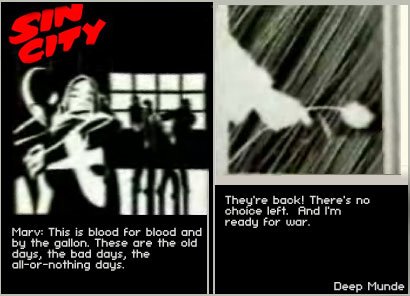Essay Plan
"Does the neo-noir genre continue to follow the representations of the classic film noir genre, with particular reference to ‘Sin City’ (2005)"
| Key | What it means |
| Purple | Links to Migrain and Shep |
| Red | Quote |
Bold | Key word |
Italic | Website Link |
Media Language (M)
Chiaroscuro lighting – Sharply contrasting lighting where strong highlights and dark shadows are cast for a dramatic and atmospheric effect. From the Italian words ‘Chiaro’, meaning ‘Bright’ and ‘Scuro’ meaning ‘Dark’.
Dutch Angle (Canted shot) – a type of camera shot, which involves tilting the camera to create a sense of disorientation.
Auteur Theory – A term to describe the decisive, creative input of a film director in determining the stylistic and ideological treatment of a film – What you see on the screen is a reflection of the directors style rather than what genre theory represents [G]
Ideology (I)
Patriarchy – male (and also world) domination in society is reflected on the silver screen [I][R]
Genre (G)
The noir genre has “various recurrent themes” (Cinema Book), crime and murder; these are continually used in both neo-noir and classic noir films. [G]
“Back in the post-WWII Hollywood era that spawned most films noir, these movies were called either Crime Thrillers or Murder Dramas” [G] http://www.greencine.com/static/primers/noir.jsp
"Schrader goes on to suggest that the fundamental reason for the neglect of noir was the importance of visual style to the form: 'American critics have been traditionally more interested in theme than style" (Cinema Book) [Wider Context – H]
Robert Stam identifies four key problems with generic labels in film:
Normativism (having preconceived ideas of criteria for genre) [A]
Biologism (a kind of essentialism in which genres are seen as evolving through a standardized life cycle) – Zeitgeist; links to how film noir is of it’s time and neo noir is of it’s time [Wider Context – S, E] (Stam 2000, 128-129).
Douglas Pye (1975) - “Generic consistency allows for the shorthand of conventions and stereotypes but also for the interplay between confirmed expectations and novelty
Andrew Taylor (1986) - "Genre is what we collectively believe it to be"
Paul Schrader suggests: "Schrader goes on to suggest that the fundamental reason for the neglect of noir was the importance of visual style to the form: 'American critics have been traditionally more interested in theme than style" – The Cinema Book
"Whoever went to the movies with any regularity during 1946 was caught in the midst of Hollywood's profound post war affection fro morbid drama. From January through December deep shadows, clutching hands, exploding revolvers, sadistic villains and heroines tormented with deeply rooted diseases of the mind flashed across the screen in a panting display of psychoneuroses, unsublimated sex and murder most foul" – This article is from a 1947 'Life' magazine within The Cinema Book.
Representation (R)
Femme fatale - “A cynical, hard-hearted, disillusioned male character, who encountered a…femme fatale. She would use her feminine wiles and come-hither sexuality to manipulate him into becoming the fall guy - often following a murder. After a betrayal or double-cross, she was frequently destroyed as well, often at the cost of the hero's life. As women during the war period were given new-found independence and better job-earning power in the homeland during the war, they would suffer -- on the screen -- in these films of the 40s.” [Wider Context, historical] [R] http://www.filmsite.org/filmnoir.html
The females in film noir were either of two types – dutiful (devoted), reliable, trustworthy and loving women; or femme fatales - mysterious, duplicitous (two faced), double-crossing, gorgeous, unloving, predatory, unreliable, irresponsible, manipulative and desperate women.
http://www.filmsite.org/filmnoir.html
Female characters in noir films reinforced Laura Mulvey’s theory on the male gaze and the characters that played the femme fatale held the quality of “to-be-looked-at-ness” [R][I][A] http://www.filmsite.org/filmnoir.html
“The femme fatale, who had also transgressed societal norms with her independent and smart, menacing actions, would bring both of them to a downfall.” [N] http://www.filmsite.org/filmnoir.html
“Heroes (or anti-heroes), corrupt characters and…these protagonists were often morally-ambiguous low-lives from the dark and gloomy underworld of violent crime and corruption. Distinctively, they were cynical, tarnished, obsessive (sexual or otherwise), brooding, menacing, sinister, sardonic, disillusioned, frightened and insecure loners (usually men), struggling to survive – and in the end, ultimately losing.” [R] http://www.filmsite.org/filmnoir.html
Although ‘Sin City’ does not have one protagonist the character of Hartigan can be identified as the most idealized version of the classic noir detective, as he is rugged, very manly and saves women time and time again.
“The figure of the femme fetale, a further trend in recent writing on noir has been an attention to issues of masculinity”… “Frank Krutnik, 1991, and for Deborah Thomas, 1992, issues of masculinity and central to Film Noir, which they see as dramatising and exploring ‘a particular crisis in male masculinity’ [R] [1]
Narrative Structure (N)
“…Low budgets and B-film status of many film noirs were seen as a priori proof that the films were 'trash” (Cinema Book) [E] http://www.filmsite.org/filmnoir.html
Sin City has 3 stories within the film, which intertwine with one another, subverting Todorov’s narrative structure theory and also subverts the typical narrative structure on a classic noir film. [N] http://www.filmsite.org/filmnoir.html
Storylines were often elliptical, non-linear and twisting. Narratives were frequently complex, maze-like and convoluted, and typically told with foreboding background music, flashbacks (or a series of flashbacks), witty, razor-sharp and acerbic dialogue, and/or reflective and confessional, first-person voice-over narration.
http://www.filmsite.org/filmnoir.html
Roland Barthes = Myth. When an ideology is repeated enough, people start to believe it. Sin City has generalized stereotypes such as men being the hero for pretty much every woman in the film.
[1] Cook, Pam; Bernink, Mieke (2003) Pg 188
Bibliography
Ltd.F.
Cook, Pam; Bernink, Mieke (2003): The Cinema Book. Stephen Street, London: British Film Insistitute.

No comments:
Post a Comment